Choosing the correct hook size can make the difference between an empty cooler and a successful day on the water. Hook size affects presentation, hook-up ratio, and fish safety.
Anglers often make the mistake of going too big or too small, resulting in missed strikes or fish that throw the hook.
Bass, catfish, and trout each have specific requirements based on their anatomy, feeding habits, and typical bait styles.
Knowing which hook suits each species can enhance your experience and lead to more consistent results.
Fishing Hook Sizes and Types
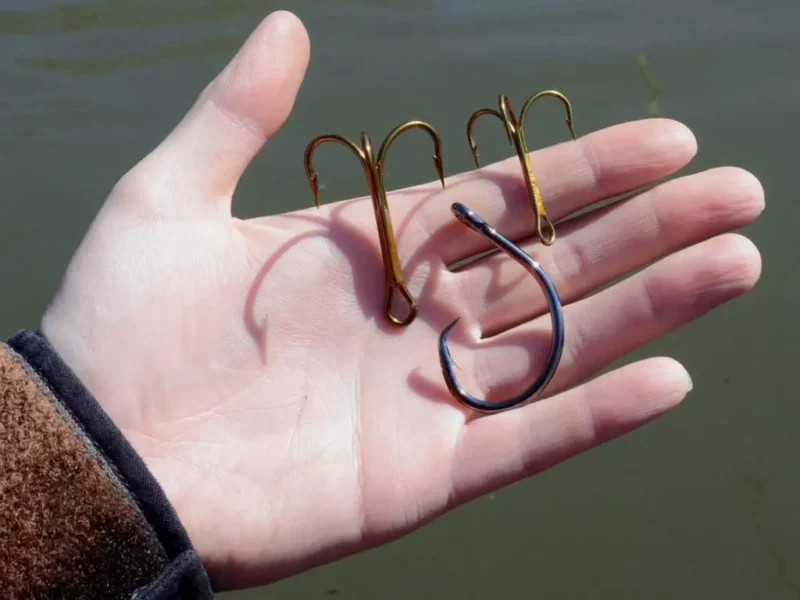
Choosing the correct hook requires familiarity with two common sizing systems. Fishing hooks are labeled using either numbered sizes or aught sizes.
These two formats work in opposite directions, and understanding them helps avoid mismatched gear and missed catches.
Numbered sizes start large and go smaller as the number increases. For example, a size #12 hook is much smaller than a size #6. These hooks are ideal for smaller species like trout, especially during light-bite conditions or finesse applications.
Once you reach size #1, the system changes. Aught sizing begins at 1/0 and increases as the number grows. A 5/0 hook is larger than a 3/0. Aught-sized hooks are typically used when targeting bigger fish like bass, catfish, or pike.
Gauge or wire thickness is another element to consider. It affects durability, strength, and how naturally the bait moves in the water. The gauge rating is shown using numbers like 1X, 2X, 3X, and 4X.
Key hook size and gauge characteristics include:
- #12 to #6: small bait use, ideal for trout and panfish
- #4 to 1: medium-sized bait, versatile across species
- 1/0 to 8/0: larger presentations, suited for big bass or catfish
- 1X to 2X: thinner wire, better bait action
- 3X to 4X: stronger build, used for heavy cover or big game fish
Basic Hook Types
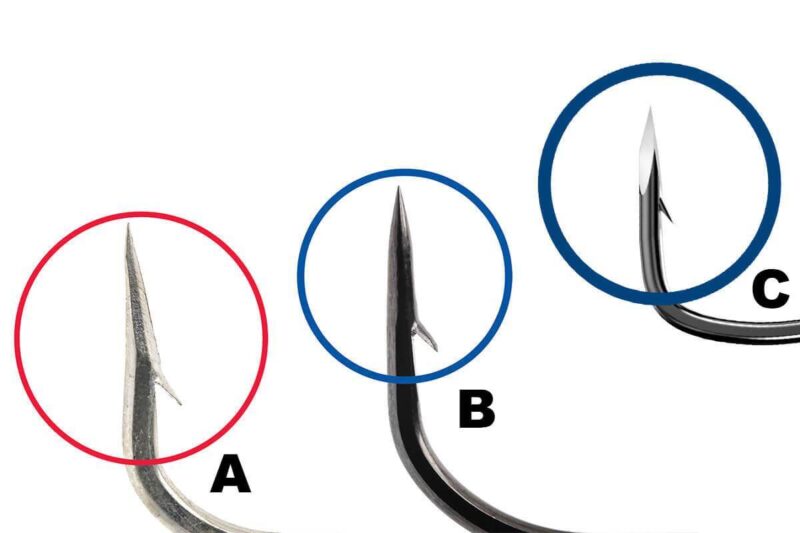
A wide variety of hook styles serve specific functions depending on bait type, fishing technique, and target species.
Below is a breakdown of the most commonly used hook types:
- J-hooks are a reliable all-around choice. Their traditional shape and easy availability make them a go-to for general setups involving both artificial and natural baits.
- Circle hooks reduce the chances of gut-hooking. Designed to slide into the corner of the fish’s mouth, these are especially helpful for catch-and-release fishing where fish safety is important.
- Treble hooks feature three evenly spaced points. Standard on crankbaits, spoons, and jerkbaits, they are effective for fish that strike hard or fast.
- Offset and EWG (Extra Wide Gap) hooks offer more clearance for bulkier soft plastics. Their design helps keep baits weedless, making them effective in heavy vegetation.
- Straight shank and bait-holder hooks work best with live bait. Barbs on the shaft keep slippery bait in place, while the straight design ensures natural presentation.
Best Hook Sizes and Styles for Bass
Bass fishing calls for a dynamic approach.
Hook size often depends on the type of bait, cover, and the specific behavior of the fish.
Hook sizes ranging from 1 to 4/0 cover most standard bass fishing scenarios.
When using soft plastic worms, lizards, or compact creature baits, 1/0 to 3/0 hooks provide the perfect balance of bite-to-hook gap.
When fishing with oversized plastics or larger baits like 10-inch ribbon-tail worms or swimbaits, hooks in the 4/0 to 6/0 range become essential. Bigger baits require wider gaps to allow proper hook exposure during the strike and to ensure deeper, more secure hooksets.
Common size recommendations for bass include:
- 1/0 to 3/0: medium plastics like finesse worms, craws, or lizards
- 4/0 to 6/0: large swimbaits, big worms, bulky creature baits
Matching hook size to bait profile improves presentation and prevents missed hookups.
Larger hooks are also better suited for fish with strong jaws and wide mouths, allowing for cleaner penetration during hooksets.
Hook Types for Bass
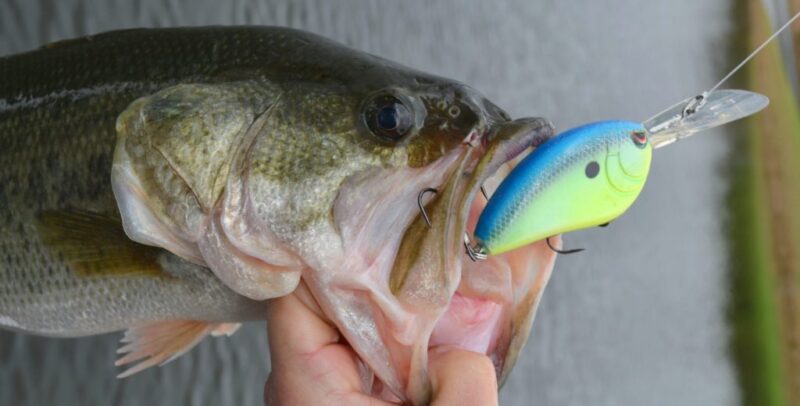
Bass respond well to a range of hook types, each fitting a different style of bait or fishing method.
Selecting the correct style ensures better bait performance and increased hook-up ratios.
- Offset worm hooks are essential for Texas-rigged setups. The bend holds soft plastics in place, while the offset shank helps present the bait weedless, especially in thick cover or around structure.
- EWG (Extra Wide Gap) hooks are preferred for bulkier baits like creature baits or thick-bodied swimbaits. Their wide arc allows for better compression during the strike, increasing the chance of a solid hookup.
- Treble hooks shine when using crankbaits, jerkbaits, or topwater lures. Their three-pronged design increases the chances of hooking a fish that swipes or bumps a moving lure.
- Circle and octopus hooks are less common in traditional bass fishing but play a role during live bait presentations. When fishing with minnows or shiners under floats or on bottom rigs, these hooks can be effective, especially when bass are less aggressive.
Best Hook Sizes and Styles for Catfish
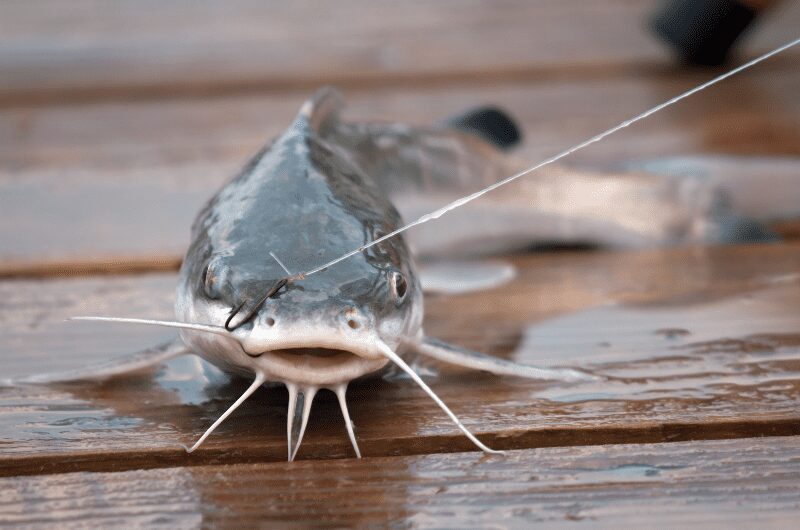
Catching catfish involves strength, patience, and the right hook. These fish are tough, muscular, and often aggressive feeders.
Hook size depends on the bait being used and the size of the targeted species. Most catfish setups use hooks in the 2/0 to 8/0 range.
Channel catfish, often smaller and more active, respond well to hooks in the 2/0 to 4/0 range when using worms, dip baits, or chicken liver.
These hooks are strong enough to hold up during the fight yet small enough to fit in the fish’s mouth without triggering suspicion.
Blue and flathead catfish require more robust gear. Hook sizes from 5/0 to 8/0 are common, especially when fishing with cut bait, live bluegill, or large chunks of shad.
These hooks allow for deep penetration and can handle hard runs and powerful headshakes.
Recommended catfish hook sizes:
- 2/0 to 4/0: channel catfish, worms, dip bait, chicken liver
- 5/0 to 8/0: blue and flathead catfish, cut bait, live bait
Using a hook that is too small risks break-offs or missed hooksets. Too large, and smaller fish may struggle to bite or take the bait naturally.
Hook Types for Catfish
Several hook types excel in catfish fishing.
Each style serves a particular function based on bait, technique, and fish behavior.
- Circle hooks dominate modern catfish fishing due to their ability to hook fish in the corner of the mouth consistently. This reduces injury and allows for safe release if needed. Circle hooks work well when fishing with live bait or cut bait using set-and-wait tactics.
- Kahle and octopus hooks handle bulkier bait effectively. These hooks provide a wider gap and are often easier to set with active fishing styles. They are especially effective when drifting or fishing in current.
- Treble hooks are common in stink bait and punch bait setups. Their three points help retain soft, sticky bait that would otherwise fall off traditional single hooks.
Best Hook Sizes and Styles for Trout
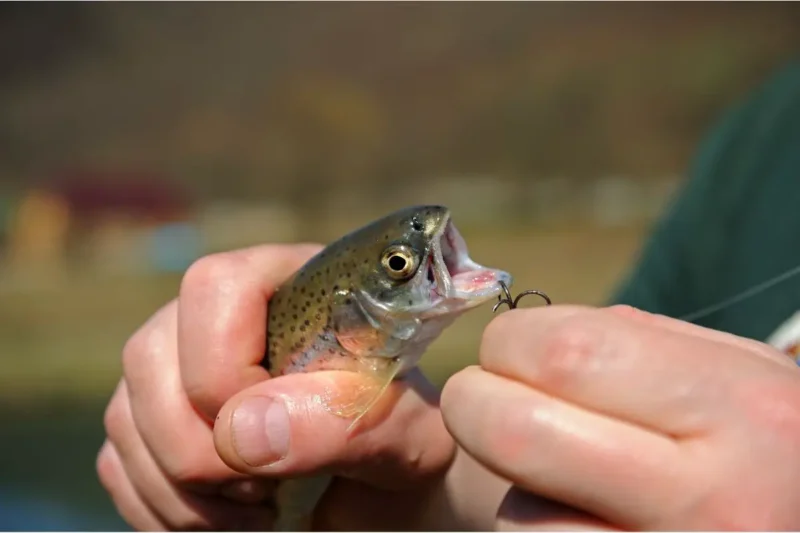
Trout fishing calls for finesse, precision, and subtle presentation. These fish have delicate mouths and often feed on small insects, larvae, or tiny baitfish.
Hook size matters significantly, as using an oversized hook can spook the fish or prevent effective penetration.
Hook sizes best suited for trout typically range from #12 to #6. For delicate bait presentations like salmon eggs, dough bait, or maggots, sizes #10 to #12 are ideal. These hooks are small enough to present naturally while still strong enough to secure a hookset.
Larger live baits such as nightcrawlers or small minnows call for slightly larger hooks in the #6 to #8 range.
These sizes balance strength and subtlety, especially when targeting larger rainbows or browns in moving water or lakes.
Suggested trout hook sizes:
- #12 to #10: salmon eggs, maggots, artificial flies
- #8 to #6: nightcrawlers, mealworms, small minnows
Trout are known to be line-shy and cautious, especially in clear or pressured water. Properly matching hook size with bait ensures a more natural look and increases the chances of a clean hookset.
Hook Types for Trout
Multiple hook types support different trout fishing techniques.
Choosing the correct one depends on bait choice and the goal of the trip, catch and release, fun fishing, or stocking up for a meal.
Baitholder hooks are ideal when fishing with worms, minnows, or other live baits.
Barbs along the shank prevent the bait from slipping during casts or current movement, keeping the presentation natural and effective.
Mosquito hooks are lightweight and ideal for finesse rigs. Their compact profile works well in drop shot setups or when fishing in ultra-clear water. These hooks are often used with artificial bait or very small live bait.
Circle hooks are gaining popularity in trout fishing, particularly for catch-and-release. Their inward-pointing design helps hook fish in the corner of the mouth, reducing injury and increasing survival rates.
Treble hooks are commonly found on lures like spoons, crankbaits, and spinners. These hooks increase the chance of connecting with fish that swipe or short-strike.
They are useful during colder months when trout become less aggressive and rely on reactive bites.
Factors That Affect Hook Choice
Selecting the best hook involves more than just matching it with a fish species. Several variables determine how well a hook will perform during a specific outing.
Bait Type
Live bait like worms, minnows, or insects typically requires smaller, thinner hooks with features that secure slippery bait. Artificial baits such as soft plastics or jigs benefit from wider gaps or specialty shapes. Cut bait demands strong, heavy-gauge hooks capable of holding dense or oily materials through long casts and river currents.
Fishing Technique
Casting, trolling, and bottom fishing all place different demands on hook performance. Circle hooks work well for passive setups like bottom fishing or float fishing, where the fish hooks itself. Active techniques like pitching or twitching lures benefit from fast-penetrating J-hooks or EWG hooks that match specific lure shapes.
Water Clarity and Cover
In clear water, smaller or thinner hooks help maintain a natural look. Heavy cover like weeds, timber, or rock structure demands stronger hooks that can handle abrupt pressure and reduce bending. Offset and weedless-style hooks shine in heavy vegetation where snags are common.
Fish Size and Mouth Structure
A largemouth bass needs a bigger hook than a similarly sized trout because of its thick jaw and aggressive strikes. Trout have fragile mouths and smaller targets, so smaller hooks with gentle angles reduce injury and increase hookups.
Hook Strength
Light wire hooks improve bait action and work well in finesse applications. Heavy wire hooks resist bending and are designed for power fishing or species with strong jaws. Matching wire gauge with rod strength and line test ensures consistent hook penetration.
Hook Maintenance and Safety
A sharp, clean hook performs better and causes less harm to fish. Neglecting basic upkeep can lead to missed strikes, bent tips, or rusted points that weaken performance or increase the risk of infection for both fish and angler.
Keeping Hooks Sharp
Frequent sharpening ensures penetration during hooksets, especially on tougher-mouthed species. A small file or sharpening stone can restore dull points in seconds. Testing sharpness by gently dragging the point across a fingernail helps determine readiness—a properly sharpened hook will grab with minimal pressure.
Preventing and Managing Rust
Moisture and saltwater exposure quickly degrade metal. Rinse hooks after each trip, especially when fishing in brackish or saltwater environments. Dry thoroughly before storing. Anti-rust coatings and desiccant packs in tackle boxes extend hook life significantly.
Safe Disposal of Damaged Hooks
Bent or blunted hooks should be discarded properly. Wrapping them in tape or placing them inside sealed containers prevents injuries to others or wildlife. Never toss damaged hooks directly into the environment or open trash bins.
Using Hook Protectors and Storage Solutions
Hook caps, small rubber sleeves, or foam boards can keep sharp points covered during transport. Tackle trays with dedicated compartments prevent tangling and tip damage.
Organizing by size and type makes setup more efficient and minimizes wasted time on the water.
Organizing by size and type makes setup more efficient and minimizes wasted time on the water.
Some anglers even use digital tracking tools or tagging systems to manage their gear more precisely, similar in function to an AI content detector that scans for hidden patterns or inconsistencies.
The Bottom Line
Choosing the correct hook size and type helps catch more fish and makes each cast more efficient. Small adjustments in size, shape, or gauge can mean the difference between a missed opportunity and a landed trophy.
Bass, catfish, and trout each respond better to specific hook combinations. Using the recommended ranges as a starting point allows room to fine-tune based on water conditions, bait type, and target behavior.
Trying different hooks within the suggested ranges can reveal what works best in your local waters. A well-matched hook improves hookup rates, protects the fish during release, and boosts overall confidence in every cast.

